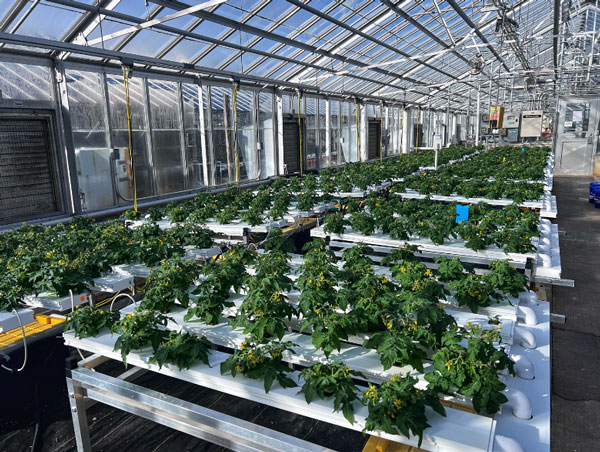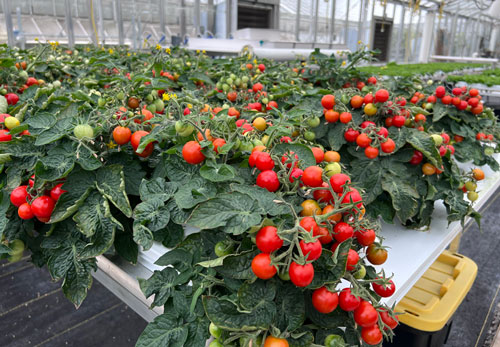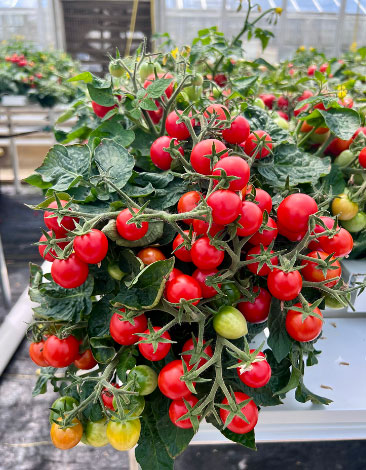4/30/2025
Tiny But Mighty
Brandan A. Shur & Michael R. Evans

Controlled environment agriculture (CEA) has significantly advanced food production by enabling year-round cultivation, optimizing resource efficiency and reducing climate-related risks. However, despite these advantages, the industry remains heavily focused on a narrow selection of crops. In particular, indoor vertical farms primarily grow leafy greens and herbs. While these crops perform well in such environments, market saturation and a lack of diversity limit profitability and long-term viability.
Left: Sixteen individual NFT hydroponic systems growing various micro-tomatoes in a greenhouse environment. Plants are 55 days post-seeding and beginning to flower.
Expanding crop diversity in CEA is essential for increasing profitability and industry development. Consumers increasingly demand fresh, locally grown produce with greater variety, while growers seek economically viable crops that maximize production efficiency.
One particularly promising candidate is the micro-tomato. As a compact, high-yielding fruiting plant, micro-tomatoes present a unique opportunity for hydroponic operations looking to diversify their offerings. Unlike conventional tomato varieties that require extensive vertical space and labor-intensive trellising, micro cultivars are ideally suited for space-limited systems. Their small stature allows for high-density planting and their relatively short growing cycle makes them attractive for year-round production.
How micros fit into hydroponics
Tomatoes rank among the most valuable horticultural crops globally, with U.S. production alone accounting for billions of dollars annually. Traditionally, controlled environment tomato production has relied on high-wire greenhouse systems that enable continuous fruiting and maximize yields. However, these systems require substantial labor, extensive pruning and considerable space, making them less accessible for smaller-scale hydroponic growers.
Due to their compact growth habit, fast maturation and reduced labor requirements, micro-tomato cultivars may be well suited for hydroponic production. Typically remaining under 30 cm in height, these plants eliminate the need for trellising and complex pruning techniques, making them highly attractive for small-scale, high-density production. While much of the existing research on micro-tomatoes has focused on container and soilless substrate growing, little work has been done to assess their performance in recirculating hydroponic systems such as Nutrient Film Technique (NFT).
NFT hydroponic systems continuously deliver a thin film of nutrient-rich water across plant roots, optimizing resource efficiency and promoting rapid growth. Although widely utilized for leafy greens, NFT remains largely unexplored for compact fruiting crops. The success of NFT-grown micro-tomatoes will depend on their ability to adapt to constant nutrient flow, develop robust root systems and maintain high yields without the stability provided by traditional growing media. Additionally, fine-tuning environmental factors such as nutrient formulations, lighting intensity and spacing will be crucial to optimizing fruit production and quality.

Testing tomatoes in a leafy green world
To investigate the viability of micro-tomato cultivars for NFT hydroponic production, we conducted a controlled study evaluating five distinct cultivars: Baby, Jochalos, Micro Tom, Pinocchio Orange and Red Velvet. The research was carried out in a greenhouse setting where plants were grown in a standard NFT system with a continuous recirculating nutrient solution.
Right and below: Red Velvet micro-tomato plants in an NFT hydroponic system with ripening fruit. Plants are at 75 days post-seeding and harvesting has begun.
Plants were seeded in rockwool cubes before being transplanted into NFT channels. The nutrient solution was maintained at an electrical conductivity (EC) of 2.0 mS/cm and adjusted as necessary to ensure optimal plant health. Environmental conditions were carefully controlled, with daytime temperatures maintained at 75F (24C) and nighttime temperatures at 64F (18C). Supplemental LED lighting was used to maintain a daily light integral (DLI) of 18 mol·m-²·d-1.
Mighty minis in action: Growth, yield and flavor
 Key growth and yield parameters were recorded, including days to flowering, days to fruiting, plant height, fruit count, average fruit weight, total fruit weight and Brix (sugar content). Statistical analysis was performed to determine significant differences among cultivars.
Key growth and yield parameters were recorded, including days to flowering, days to fruiting, plant height, fruit count, average fruit weight, total fruit weight and Brix (sugar content). Statistical analysis was performed to determine significant differences among cultivars.
Growth and development: Days to flowering ranged from 40.1 to 42.5 days across cultivars, with Jochalos requiring the longest period before anthesis. Micro Tom initiated flowering the earliest at 40.1 days, followed closely by Baby (40.9 days) and Red Velvet (41.1 days). Time to first fruit harvest varied more widely, with Red Velvet reaching harvest in 76.5 days, whereas Baby required 81.2 days. Jochalos and Micro Tom were intermediate at 77.7 and 78.1 days, respectively. These differences suggest that growers can strategically select cultivars to align with production schedules and maximize turnover rates in hydroponic systems.
Plant height ranged from 20.4 cm in Micro Tom to 40.1 cm in Pinocchio Orange, indicating notable variation in growth habit. Jochalos (35.7 cm) and Red Velvet (31.0 cm) exhibited moderate growth, while Baby remained compact at 23.8 cm. Given the constraints of high-density hydroponic production, compact cultivars such as Micro Tom and Baby may be more suitable for maximizing plant numbers per unit area, while taller cultivars may require greater spacing or support structures to avoid shading effects.
Yield and fruit quality: Fruit number per plant varied significantly, with Micro Tom producing the highest number of fruits, while larger cultivars such as Jochalos and Pinocchio Orange produced fewer, but potentially larger, fruits. Although Micro Tom exhibited high fruit count, Baby and Red Velvet produced the largest individual fruits, with average fruit weights suggesting a tradeoff between fruit number and size. These findings indicate that cultivar selection should balance yield potential with fruit size, which may influence market preferences.
Total fruit yield per plant was highest in Red Velvet, followed by Micro Tom, while Jochalos produced the lowest yield. This suggests that while some cultivars may produce a higher quantity of fruits, total fruit mass remains a crucial metric when evaluating overall productivity.
Fruit sweetness, measured as soluble solids content (Brix), varied across cultivars, with Red Velvet demonstrating higher sugar accumulation compared to Jochalos. This variation in fruit chemistry underscores the importance of cultivar selection in optimizing flavor for consumer preferences and marketability.
Economic considerations: Yield efficiency in NFT hydroponics
The economic viability of micro-tomatoes in NFT hydroponics depends on factors such as planting density, cultivar selection and environmental conditions. Based on preliminary trials, a planting density of 25 to 30 plants per square meter may be achievable. High-yielding cultivars like Red Velvet have the potential to produce approximately 8.75 to 10.5 kg/m² per production cycle, assuming an average yield of ~350 grams per plant per cycle. However, actual yields will vary depending on specific growing conditions.
Given a growth cycle of approximately 80 to 90 days, careful planning of seedling transplant successions could minimize downtime between cycles, potentially allowing for five to six production cycles per year under optimal conditions. If these assumptions hold, annual production could range from approximately 43.8 to 63.0 kg/m². Additionally, integrating vertical farming systems could significantly increase total yield by utilizing multiple production layers within the same footprint, maximizing space efficiency and output. Further data collection is underway to refine production timelines and yield estimates to support the development of a grower enterprise budget model.
Compared to traditional field-grown cherry tomatoes, which typically yield 2 to 4 kg per plant per season (or approximately 10 to 20 kg/m² per year), micro-tomatoes in NFT hydroponic systems may offer competitive yields while enabling year-round production and precise environmental control. Additionally, greenhouse-grown high-wire cherry tomatoes in hydroponic systems can yield 25 to 50 kg/m² annually. While micro varieties do not serve as direct replacements, their compact growth habit may allow for integration into vertical production models or diversification of hydroponic crop offerings.
These findings highlight the potential for micro-tomatoes to serve as a viable hydroponic crop, particularly for growers seeking to maximize production efficiency in small-footprint systems while offering a high-value specialty product. Additionally, the reduced labor associated with micros—due to their lack of trellising and minimal pruning requirements—further enhances their economic appeal. Compared to traditional indeterminate tomato systems, where labor and infrastructure costs are substantial, micro cultivars offer a streamlined, lower-maintenance alternative.
Looking ahead: Flavor optimization through nutrient management
While this study establishes micro-tomatoes as a viable crop for NFT hydroponics, further research is needed to optimize fruit quality, particularly in terms of flavor. One promising avenue for future exploration is the role of electrical conductivity (EC) in enhancing tomato flavor. Higher EC levels have been associated with increased sugar and acid content, potentially improving the overall taste profile of hydroponically grown tomatoes.
Additionally, the type of salts used to increase EC (NaCl, KCl, CaCl2) may influence fruit chemistry differently, impacting the balance of sweetness, acidity and aromatic compounds. Future studies will delve into the effects of EC manipulation on micro-tomato flavor, investigating how strategic nutrient adjustments can enhance sweetness, acidity and aromatic compounds. Research will also examine how the timing of high EC application—whether during vegetative, flowering or fruiting stages—affects overall fruit development and flavor intensity. By refining nutrient management strategies, we aim to further elevate the appeal of NFT-grown micro-tomatoes, solidifying their place as a valuable crop in controlled environment agriculture.
Brandan A. Shur is a Ph.D. researcher in Controlled Environment Agriculture (CEA) at Virginia Tech in the School of Plant and Environmental Sciences’ CEA Innovation Lab. Michael R. Evans is a professor specializing in CEA and co-director of the CEA Innovation Center in the School of Plant and Environmental Sciences at Virginia Tech. For questions, contact Brandan at bashur@vt.edu.